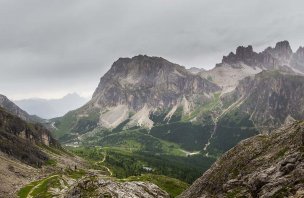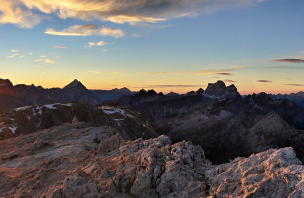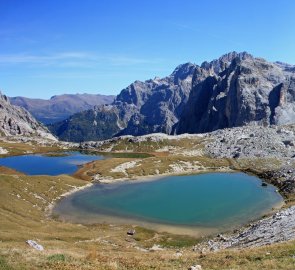Trek with the best ferrata in the Sexten Dolomites
Mountain range, region / State
Dolomites in Alps / Italy
Season
Fall
28. 09. - 30. 09. 2016
Difficulty
3 / 5
Elevation
↑ 2615 m
↓ 3179 m
Length
24.3 km
3 days
Altitude
max. 2744 m n.m.
min. 1357 m n.m.
Tips for hikes in the mountain range Dolomites in Alps

6-day crossing of the Dolomites along the Alta Via 1 route

Circular trek at the waterfalls in the Fanes Sennes Braies park in the Dolomites

Circuit trek with ferrata around Monte Paterno
Tour of the Sexten Dolomites with ascent to Monte Paterno and the Alpinisteig, Percorso delle Forcelle and Innerkofler ferratas
Starting point
We parked the car in Bad Moos at the bottom station of the cable car to the Rudi hut. At the time of our visit the parking was free. Another option is to drive about three kilometers further to the parking lot in the Fiscalina valley. There, on our next visit, we paid 20 euros for three days.
Description of the hike
1. day
This route described here is a combination of several treks we have done over the years. There is no point in describing each trek separately, so I have combined the trek that in my opinion is the best I have done in the years I have been coming to the Sexten Dolomites.
We started the trek in the village of Bad Moss, where we bought our lift tickets on the first morning and rode up to the Rudi hut 1,950m above sea level. From the hut, we then continued along trail #100 and then along trail #104 to the Undici saddle, where the Alpinisteig ferrata itself begins.
The route leads first along a comfortable walkway (photo) until you reach the foot of the Torre Undici wall. Here begins the most interesting and beautiful section of the Alpinisteig. The trail was cut by soldiers during the First World War and used as a supply route. From the opposite slope you can see almost the entire rock shelf and you feel like you can't pass this (photo). The ramp is less than a kilometer long and less than half a meter wide in places.
When you reach the very beginning of the rock shelf it doesn't look so bad. There is a rope stretched along the whole length. The first time we were here, we tied ourselves to ferrata harnesses, but for an experienced hiker, a harness is not necessary. This is of course true if the weather conditions are ideal. In wet or snowy conditions a belay is very useful.
A helmet is a must in all conditions. You are going through a vertical wall from which sometimes some rocks fall and the trail is literally cut into the rock. Sometimes you have to walk on all fours and in this case you will be glad for your helmet. If you suffer from vertigo, don't take this trail. After passing this section, we can see the Giralba 2,431 m above sea level, which is where we are heading.
After a few hundred metres we see the Zsigmondy hut about a hundred metres below us, above which there is a strong spring. In any case, it is good to go down those few metres to refill the water. After ascending through the rubble to the Giralba saddle, we continue along a comfortable and wide path towards the Pian di Cengia 2 528 m hut, where we end the first day of the trip.
You can spend the night above the hut, where you can find a flatter plain, or when the season is over, we spent the night on the wooden terrace right next to the hut (photo). There is a spring of water a short distance after the hut.
2. day
The next day we head to Monte Paterno. At the saddle of Pian di Cengia there is a possibility to turn onto the comfortable trail 101, which leads under the rocks of Monte Paterna - if you don't want to climb the Paterna ferrata. We continued on first along the trail and then the via ferrata Percorso delle Forcelle starts in the Monte Paterno massif. You climb on rock shelves and ramps, you climb rock walls and towers, it's up and down, but don't worry, you won't lose any height (photo).
After about two hours we reach the ferrat crossing. On the left is a ferrata that starts at the Lavaredo saddle. We have also walked it several times in the past - you can read it in detail in this trek.
We will continue straight along the perpendicular rock directly to the top of Paterna. We left our packs in one of the adits - after all, it is much easier than with a pack on our backs. After crossing the first wall, the ferrata splits and it basically doesn't matter which option we choose.
I found the right branch more suitable for ascent and the left for descent, but it depends on the taste of each hiker. The top part of the ferrata to Paterno is not very long. It is from the saddle where we left our packs for about 200 vertical meters. After about half an hour we are at the top. The very top of Monte Paterno at 2,744 m above sea level is a great vantage point. Especially the view of the teeth of Tre Cime is fantastic but we can also see a substantial part of the Sexten Dolomites and the jagged Marmarole ridge to the south.
After descending into the saddle, continue down the Innerkofler Ferrata to the Locatelli hut. This section is not particularly difficult either, but again, it depends on the conditions. In wet weather it is dangerous, in snow it is on the edge of passability. After descending through the rock rib we descend to the mouth of the tunnel, again built during the war. Without a headlamp or torch, the tunnel is impassable.
If you don't want to go through the tunnel, you can turn right in front of it and climb down the wall to the top of the debris field and follow the path down to the 101 between the Cengia saddle and the Locatelli hut. The tunnel is about half a kilometre long and sometimes there are shafts and tunnels carved in it through which daylight can penetrate, otherwise the tunnel is dark. The tunnel is quite low in places, so definitely do not take off your helmet, and it goes down quite a lot of steps during the passage, so you have to be careful.
After exiting the tunnel, it is only a short walk to the Locatelli Hut at 2,405 m above sea level. Here we finished the second day. There are a lot of people at the hut even in the off-season if the weather is nice. So we waited for the last tourists to leave and made our beds on the covered terrace right next to the hut. About thirty meters from the hut there is a separate building that serves as a winteraum, but we did not use it.
3. day
On the morning of the third day, after the obligatory photo shoot of the sunlit Tre Cime, we packed up and headed down trail 102 into the Fiscalinna valley, arriving at the car after about three hours of descending. This was the end of our trek in the Sexten Dolomites.
Difficulty
The trek is a combination of hiking trails and via ferrat. We have combined it so that we can see the most important and beautiful things the Sexten Dolomites have to offer. A hiker used to navigating the more exposed passages will enjoy these sections to the fullest. Of course, the resistance to vertigo is a must. Depending on the conditions, this venture can be described as moderate to difficult in the event of snow cover. In case of snow or ice without crampons impassable.
Water availability
Water is a problem at higher elevations, especially in summer and late summer. In season it can be bought at the Zsigmondy cottages -rif. Clean and abundant springs are above the Zsigmondy hut and a few metres next to the Pian di Cengia hut. There is plenty of water at Locatelli hut but we have already filtered it there, after all, cattle graze there in summer and the water can be polluted.
Sleeping options
You can sleep for one night practically anywhere you can find a flat spot. Once we were caught in the dark right on Alpinisteig and had to sleep on the pavement.
Of course there are possibilities to sleep in the huts on the route, but they are overcrowded during the season. It's not a problem to climb a bit outside the huts, find a flat spot and sleep under a tent. We use tarpaulins from Jurek, they are much lighter than tents and for most of the year they are enough protection from the vagaries of the weather. We've slept many nights in the wild in the Dolomites and never had a problem. Of course, it is important to leave the place without anyone knowing you were there.
Mountain peaks
In the case of Alpinisteig, the journey itself is the goal. Fantastically run in a beautiful setting, it is hard to find competition. Monte Paterno is already a peak as it should be. From the viewpoint of the Locatelli hut it looks like a spike to which no paths lead, but the climb up the mountain is not difficult. The view from above is fantastic, especially of the teeth of Tre Cime. But from the top of Monte Paterno we can also see a substantial part of the Sexten Dolomites and other peaks. In the south, it is mainly the Marmarole ridge.
Danger
There is a danger especially in wet weather. In the event of snow, the Alpinisteig is impassable without crampons, the same applies to Monte Paterno. A helmet is essential in these more exposed sections. Of course, resistance to vertigo is a must.
Equipment
For this trek, classic equipment for sheltered routes is necessary - ferrata set with brake, helmet. Cycling gloves are good to protect your hands from rubbing against rocks or steel cables. A headlamp is definitely necessary for the gullies. For sleeping outside the huts, of course, a good quality sleeping bag, a mattress.
Food
We have tried everything to eat since we have been going to the mountains. After years of trying, we finally take for example oatmeal from Lidl, in health food you can buy excellent instant soups, it weighs nothing and you eat quite well. We also tried dehydrated food but I didn't like it very much. Otherwise, classic protein bars, chocolates and always at least one beer in a can. Of course, we always take the used cans back to civilization.
Attractions
There are so many interesting places in the whole area of the Sexten Dolomites that it would take several separate reports. The whole area was fought fiercely during the First World War and the remains are still visible today and will be for a long time to come. We have found bullets, for example, and it is not rare to find bone fragments from the victims of the fighting.
If I may, I recommend a book by Milan Čepelka: The Front in the Dolomites 1915-1917. It is very engagingly written and for me personally this book has become the best guide to these beautiful mountains.




















